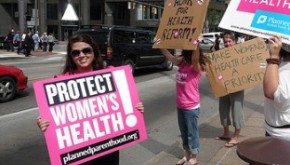Safeguarding women’s health
Imagine you are a young mother living paycheck to paycheck, with no health insurance. Where would you go for a pregnancy test? For treatment of a sexually transmitted disease? To obtain contraceptives? In each case, the answer for millions of Americans is Planned Parenthood.
Planned Parenthood is also where many women go for abortions. That is ostensibly why the organization was under attack by Republicans during negotiations over the 2011 budget. The House of Representatives voted to strip the organization of federal funding, though the bill was defeated in the Senate.
Read our latest issue or browse back issues.
Since Planned Parenthood was already barred by law from using federal money for abortions, it was clear that what really irked opponents was the very existence of an organization like Planned Parenthood. Critics resorted to wild exaggeration. "Ninety percent of what Planned Parenthood does is provide abortions," said Senator John Kyl (R., Ariz.), a claim so inaccurate that his staff was forced to say that it was "not intended to be a factual statement." In reality, about 3 percent of Planned Parenthood's budget goes to providing abortions. Most of the care it provides is preventive—pap smears, breast exams, family planning and a range of other services, all at fees significantly reduced to be affordable for those with low incomes.
The attack on Planned Parenthood is part of a broader assault on the sexual health of low-income women, evident in the House's vote to eliminate funding for Title X, the federal program that since 1970 has provided low-income women with birth control, cancer screenings and testing for HIV and other STDs. In signing the bill into law, President Nixon stated what until recently was an uncontroversial, bipartisan conviction: "No American woman should be denied access to family planning assistance because of her economic condition."
If the goal is indeed to reduce the number of abortions, then it is absurd to defund programs like Title X that help reduce the number of unwanted pregnancies. The Guttmacher Institute, a leading authority on reproductive health, estimates that in 2008 Title X–supported family planning centers "helped women and couples avoid 973,000 unintended pregnancies, which would have resulted in 433,000 unplanned births and 406,000 abortions." If they were truly serious about reducing abortions, legislators would be calling for increasing the Title X budget, not cutting it.
It is also absurd to attack women's health programs under the banner of fiscal austerity. The money involved is negligible, but if saving money is the issue, the numbers line up on the side of supporting Title X. According to Guttmacher, by helping women avoid unintended pregnancies, Title X–supported centers saved taxpayers almost $4 for every $1 spent on contraceptive care.
Anyone who cares about women's health, fiscal responsibility and reducing abortions will support Title X and programs like Planned Parenthood.






